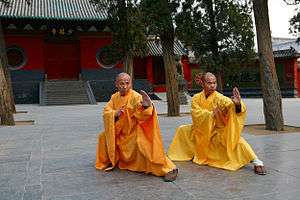Wu (Hao)-style t'ai chi ch'uan
| Also known as |
Wu (Hao)-style taijiquan Wu (Hao) family taijiquan Wu (Hao) school of taijiquan Wu (Hao) shi taijiquan |
|---|---|
| Date founded | mid-19th century |
| Country of origin | China |
| Founder | Wu Yuxiang |
| Current head |
Liu Jishun (刘积顺) 6th gen. Wu (Hao) |
| Arts taught | T'ai chi ch'uan |
| Ancestor arts |
Chen-style taijiquan, Zhaobao-style taijiquan, Yang-style taijiquan |
| Descendant arts | Sun-style taijiquan |
| Practitioners |
Li Yiyu (李亦畬), Hao Weizhen, Hao Yueru (郝月如), Hao Shaoru (郝少如) |
| Part of a series on |
| Chinese martial arts (Wushu) |
|---|
 |
|
Styles of Chinese martial arts
|
| Wushu in the world |
|
Historical locations Chen Village (陳家溝) |
| Wushu athletes/practitioners |
|
Legendary figures Bodhidharma (菩提達摩) |
|
Historical individuals Yue Fei (岳飛; 1103—1142) |
|
Modern celebrities Bruce Lee (李小龍 1940—1973) |
| Wushu influence |
|
Related |
The Wu or Wu (Hao)-style (Chinese: 武氏 or 武/郝氏; pinyin: Wǔshì or wǔ/hǎoshì) of t'ai chi ch'uan of Wu Yu-hsiang (武禹襄, 1813–1880), is a separate family style from the more popular Wu-style (吳氏) of Wu Chien-ch'üan. Wu Yu-hsiang's style was third among the five t'ai chi ch'uan families in seniority and is fifth in terms of popularity.
History
Wu Yu-hsiang was a scholar from a wealthy and influential family who became a senior student (along with his two older brothers Wu Ch'eng-ch'ing and Wu Ju-ch'ing) of Yang Lu-ch'an. There is a body of writing attributed to Wu Yu-hsiang on the subject of t'ai chi theory, writings that are considered influential by many other schools not directly associated with his style. Wu Yu-hsiang also studied for a brief time with a teacher from the Chen family, Chen Ch'ing-p'ing, to whom he was introduced by Yang. His most famous student was his nephew, Li I-yü (李亦畬; 1832–1892), who also authored several important works on t'ai chi ch'uan. Li I-yü had a younger brother who was also credited as an author of at least one work on the subject of t'ai chi ch'uan, Li Ch'i-hsüan. Li I-yü taught Hao Wei-chen (郝為真; 1842–1920), who taught Li Xiang-yuan, Li Shengduan, Sun Lutang, his son Hao Yüeh-ru (郝月如) and others. Sun Lutang later on created Sun style Tai Chi. Hao Yüeh-ru in turn taught his son Hao Shaoru (Hǎo Shǎorú, 郝少如) Wu Yu-hsiang's style of training, so that it is now sometimes known as Wu/Hao or just Hao style t'ai chi ch'uan. Hao Yüeh-ru was teaching in the 1920s, a time when t'ai chi ch'uan was experiencing an initial degree of popularity, and he is known for having smoothed out (in the sense of under-emphasising jumps and snap kicks, etc.) and standardized the forms he learned from his father in order to more effectively teach large numbers of beginners. Other famous t'ai chi ch'uan teachers, notably Yang Ch'eng-fu, Wu Chien-ch'üan and Wu Kung-i, made similar modifications to their beginning level forms around the same time.
Wu Yu-hsiang's t'ai chi ch'uan is a distinctive style with small, subtle movements; highly focused on balance, sensitivity and internal ch'i development. It is a rare style today, especially compared with the other major styles. While there are direct descendants of Li I-yü and Li Ch'i-hsüan still teaching in China, there are no longer Hao family members teaching the style. The inheritors to learn under Hao Shaoru currently living are :
- Hao Yinru (Chinese: 郝吟如; pinyin: Hǎo Yínrú; 1958), who is Hao Shaoru's adopted son in the martial tradition. As Hao Shaoru didn't have a son, he chose a close disciple and gave him the name Hao Yinru. Hao Yinru is currently teaching Wu-style t'ai chi ch'uan in Shanghai.
- Li Wei Ming (Chinese: 李伟明; pinyin: Li Wěimíng), who is Hao Shaoru's adopted son and disciple. Li Wei Ming is currently flying between Bangkok, Thailand and Shanghai, China to teach Wu-style t'ai chi ch'uan.
- Liu Jishun (Chinese: 刘积顺; pinyin: Liú Jīshùn), who has many students around the globe but only two disciples in the United Kingdom.
| Family of Wu (Hao)-style t'ai chi ch'uan lineage tree | |||||||||||||||||||||||||||||||||||||||||||||||||||||||||||||||||||||||||||||||||||||||||||||||||||||||||||||||||||||||||||||||||||||||||||||||||||||||||||||||||||||||||||||||||||||||||||||||||||||||||||||||||||||||||||||||||||||||||||||||||||||||||||||||||||||||||||||||||||||||||||||||||||||||||||||||||||||||||||||||||||||||||||||||||||||||||||||||||||||||||||||||||||||||||||||||||||||||||||||||||||||||||||||||||||||||||||||||||||||||||||||||||||||||||||||||||||||||||||||||||||||||||||||||||||||||||||||||||||||||||||||||||||||||||||||||||||||||||||||||||||||||||||||||||||||||||||||||||||||||||||||||||||||||||||||||||||||||||||||||||||||||||||||||||||||||||||||||||||||||||||||||||||||||||||||||||||||||||||||||||||||||||||||||||||||||||||||||||||||||||||||||||||||||||||||||||||||||||||||||||||||||||||||||||||||||||||||||||||||||||||||||||||||||||||||||||||||||||||||||||||||||||||||||||||||||||||||||||||||||||||||||||||||||||||||||||||||||||||||||||||||||||||||||||||||||||||||||||||||||
|---|---|---|---|---|---|---|---|---|---|---|---|---|---|---|---|---|---|---|---|---|---|---|---|---|---|---|---|---|---|---|---|---|---|---|---|---|---|---|---|---|---|---|---|---|---|---|---|---|---|---|---|---|---|---|---|---|---|---|---|---|---|---|---|---|---|---|---|---|---|---|---|---|---|---|---|---|---|---|---|---|---|---|---|---|---|---|---|---|---|---|---|---|---|---|---|---|---|---|---|---|---|---|---|---|---|---|---|---|---|---|---|---|---|---|---|---|---|---|---|---|---|---|---|---|---|---|---|---|---|---|---|---|---|---|---|---|---|---|---|---|---|---|---|---|---|---|---|---|---|---|---|---|---|---|---|---|---|---|---|---|---|---|---|---|---|---|---|---|---|---|---|---|---|---|---|---|---|---|---|---|---|---|---|---|---|---|---|---|---|---|---|---|---|---|---|---|---|---|---|---|---|---|---|---|---|---|---|---|---|---|---|---|---|---|---|---|---|---|---|---|---|---|---|---|---|---|---|---|---|---|---|---|---|---|---|---|---|---|---|---|---|---|---|---|---|---|---|---|---|---|---|---|---|---|---|---|---|---|---|---|---|---|---|---|---|---|---|---|---|---|---|---|---|---|---|---|---|---|---|---|---|---|---|---|---|---|---|---|---|---|---|---|---|---|---|---|---|---|---|---|---|---|---|---|---|---|---|---|---|---|---|---|---|---|---|---|---|---|---|---|---|---|---|---|---|---|---|---|---|---|---|---|---|---|---|---|---|---|---|---|---|---|---|---|---|---|---|---|---|---|---|---|---|---|---|---|---|---|---|---|---|---|---|---|---|---|---|---|---|---|---|---|---|---|---|---|---|---|---|---|---|---|---|---|---|---|---|---|---|---|---|---|---|---|---|---|---|---|---|---|---|---|---|---|---|---|---|---|---|---|---|---|---|---|---|---|---|---|---|---|---|---|---|---|---|---|---|---|---|---|---|---|---|---|---|---|---|---|---|---|---|---|---|---|---|---|---|---|---|---|---|---|---|---|---|---|---|---|---|---|---|---|---|---|---|---|---|---|---|---|---|---|---|---|---|---|---|---|---|---|---|---|---|---|---|---|---|---|---|---|---|---|---|---|---|---|---|---|---|---|---|---|---|---|---|---|---|---|---|---|---|---|---|---|---|---|---|---|---|---|---|---|---|---|---|---|---|---|---|---|---|---|---|---|---|---|---|---|---|---|---|---|---|---|---|---|---|---|---|---|---|---|---|---|---|---|---|---|---|---|---|---|---|---|---|---|---|---|---|---|---|---|---|---|---|---|---|---|---|---|---|---|---|---|---|---|---|---|---|---|---|---|---|---|---|---|---|---|---|---|---|---|---|---|---|---|---|---|---|---|---|---|---|---|---|---|---|---|---|---|---|---|---|---|---|---|---|---|---|---|---|---|---|---|---|---|---|---|---|---|---|---|---|---|---|---|---|---|---|---|---|---|---|---|---|---|---|---|---|---|---|---|---|---|---|---|---|---|---|---|---|---|---|---|---|---|---|---|---|---|---|---|---|---|---|---|---|---|---|---|---|---|---|---|---|---|---|---|---|---|---|---|---|---|---|---|---|---|---|---|---|---|---|---|---|---|---|---|---|---|---|---|---|---|---|---|---|---|---|---|---|---|---|---|---|---|---|---|---|---|---|---|---|---|---|---|---|---|---|---|---|---|---|---|---|---|---|---|---|---|---|---|---|---|---|---|---|---|---|---|---|---|---|---|---|---|---|---|---|---|---|---|---|---|---|---|---|---|---|---|---|---|---|---|---|---|---|---|---|---|---|---|---|---|---|---|---|---|---|---|---|---|---|---|---|---|---|---|---|---|---|---|---|---|---|---|---|---|---|---|---|---|---|---|---|---|---|---|---|---|---|---|---|---|---|---|---|---|---|---|---|---|---|---|---|---|---|---|---|---|---|---|---|---|---|---|---|---|---|---|---|---|---|---|---|---|---|---|---|---|---|---|---|---|---|---|---|---|---|---|---|---|---|---|---|---|---|---|---|---|---|---|---|---|---|---|---|---|---|---|---|---|---|---|---|---|---|---|---|---|---|---|---|---|---|---|---|---|---|---|---|---|---|---|---|---|---|---|---|---|---|---|---|---|---|---|---|---|---|---|---|---|---|---|---|---|---|---|---|---|---|---|---|---|---|---|---|---|---|---|---|---|---|---|---|---|---|---|---|---|---|---|---|---|---|---|---|---|---|---|---|---|---|---|---|---|---|---|---|
| |||||||||||||||||||||||||||||||||||||||||||||||||||||||||||||||||||||||||||||||||||||||||||||||||||||||||||||||||||||||||||||||||||||||||||||||||||||||||||||||||||||||||||||||||||||||||||||||||||||||||||||||||||||||||||||||||||||||||||||||||||||||||||||||||||||||||||||||||||||||||||||||||||||||||||||||||||||||||||||||||||||||||||||||||||||||||||||||||||||||||||||||||||||||||||||||||||||||||||||||||||||||||||||||||||||||||||||||||||||||||||||||||||||||||||||||||||||||||||||||||||||||||||||||||||||||||||||||||||||||||||||||||||||||||||||||||||||||||||||||||||||||||||||||||||||||||||||||||||||||||||||||||||||||||||||||||||||||||||||||||||||||||||||||||||||||||||||||||||||||||||||||||||||||||||||||||||||||||||||||||||||||||||||||||||||||||||||||||||||||||||||||||||||||||||||||||||||||||||||||||||||||||||||||||||||||||||||||||||||||||||||||||||||||||||||||||||||||||||||||||||||||||||||||||||||||||||||||||||||||||||||||||||||||||||||||||||||||||||||||||||||||||||||||||||||||||||||||||||||||
Note:
| |||||||||||||||||||||||||||||||||||||||||||||||||||||||||||||||||||||||||||||||||||||||||||||||||||||||||||||||||||||||||||||||||||||||||||||||||||||||||||||||||||||||||||||||||||||||||||||||||||||||||||||||||||||||||||||||||||||||||||||||||||||||||||||||||||||||||||||||||||||||||||||||||||||||||||||||||||||||||||||||||||||||||||||||||||||||||||||||||||||||||||||||||||||||||||||||||||||||||||||||||||||||||||||||||||||||||||||||||||||||||||||||||||||||||||||||||||||||||||||||||||||||||||||||||||||||||||||||||||||||||||||||||||||||||||||||||||||||||||||||||||||||||||||||||||||||||||||||||||||||||||||||||||||||||||||||||||||||||||||||||||||||||||||||||||||||||||||||||||||||||||||||||||||||||||||||||||||||||||||||||||||||||||||||||||||||||||||||||||||||||||||||||||||||||||||||||||||||||||||||||||||||||||||||||||||||||||||||||||||||||||||||||||||||||||||||||||||||||||||||||||||||||||||||||||||||||||||||||||||||||||||||||||||||||||||||||||||||||||||||||||||||||||||||||||||||||||||||||||||||
Notes
References
- Wile, Douglas Lost T'ai-chi Classics from the late Ch'ing Dynasty (1996) State University of New York Press, Albany. ISBN 0-7914-2653-X
External links
- Wu (Hao) Taijiquan Association United States
- Wu (Hao) Taichiquan Association Thailand
- Wu-Style Hao Family Taijiquan United Kingdom
- Video of Hao Taichiquan (96 forms) by Master Li, Wei-ming
- Google video of Hao Shaoru doing a Wu-style form
- Wu (Hao) Tai Chi Online Study